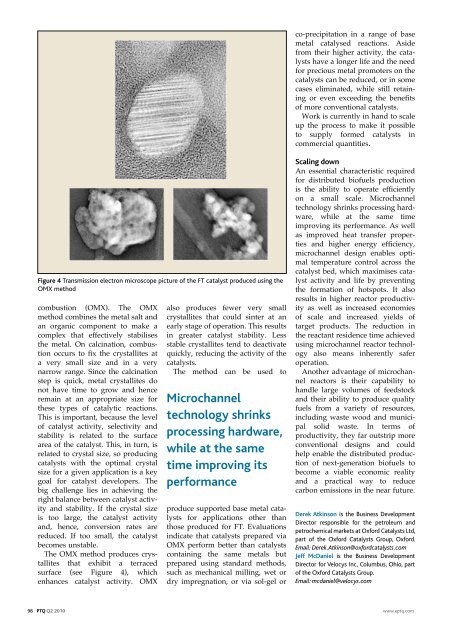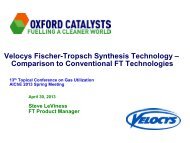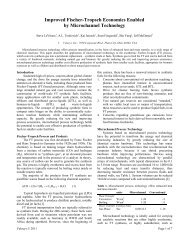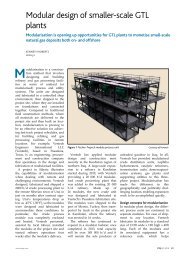Microchannel reactors in fuel production - Oxford Catalysts Group
Microchannel reactors in fuel production - Oxford Catalysts Group
Microchannel reactors in fuel production - Oxford Catalysts Group
You also want an ePaper? Increase the reach of your titles
YUMPU automatically turns print PDFs into web optimized ePapers that Google loves.
co-precipitation <strong>in</strong> a range of base<br />
metal catalysed reactions. Aside<br />
from their higher activity, the catalysts<br />
have a longer life and the need<br />
for precious metal promoters on the<br />
catalysts can be reduced, or <strong>in</strong> some<br />
cases elim<strong>in</strong>ated, while still reta<strong>in</strong><strong>in</strong>g<br />
or even exceed<strong>in</strong>g the benefits<br />
of more conventional catalysts.<br />
Work is currently <strong>in</strong> hand to scale<br />
up the process to make it possible<br />
to supply formed catalysts <strong>in</strong><br />
commercial quantities.<br />
Figure 4 Transmission electron microscope picture of the FT catalyst produced us<strong>in</strong>g the<br />
OMX method<br />
combustion (OMX). The OMX<br />
method comb<strong>in</strong>es the metal salt and<br />
an organic component to make a<br />
complex that effectively stabilises<br />
the metal. On calc<strong>in</strong>ation, combustion<br />
occurs to fix the crystallites at<br />
a very small size and <strong>in</strong> a very<br />
narrow range. S<strong>in</strong>ce the calc<strong>in</strong>ation<br />
step is quick, metal crystallites do<br />
not have time to grow and hence<br />
rema<strong>in</strong> at an appropriate size for<br />
these types of catalytic reactions.<br />
This is important, because the level<br />
of catalyst activity, selectivity and<br />
stability is related to the surface<br />
area of the catalyst. This, <strong>in</strong> turn, is<br />
related to crystal size, so produc<strong>in</strong>g<br />
catalysts with the optimal crystal<br />
size for a given application is a key<br />
goal for catalyst developers. The<br />
big challenge lies <strong>in</strong> achiev<strong>in</strong>g the<br />
right balance between catalyst activity<br />
and stability. If the crystal size<br />
is too large, the catalyst activity<br />
and, hence, conversion rates are<br />
reduced. If too small, the catalyst<br />
becomes unstable.<br />
The OMX method produces crystallites<br />
that exhibit a terraced<br />
surface (see Figure 4), which<br />
enhances catalyst activity. OMX<br />
also produces fewer very small<br />
crystallites that could s<strong>in</strong>ter at an<br />
early stage of operation. This results<br />
<strong>in</strong> greater catalyst stability. Less<br />
stable crystallites tend to deactivate<br />
quickly, reduc<strong>in</strong>g the activity of the<br />
catalysts.<br />
The method can be used to<br />
<strong>Microchannel</strong><br />
technology shr<strong>in</strong>ks<br />
process<strong>in</strong>g hardware,<br />
while at the same<br />
time improv<strong>in</strong>g its<br />
performance<br />
produce supported base metal catalysts<br />
for applications other than<br />
those produced for FT. Evaluations<br />
<strong>in</strong>dicate that catalysts prepared via<br />
OMX perform better than catalysts<br />
conta<strong>in</strong><strong>in</strong>g the same metals but<br />
prepared us<strong>in</strong>g standard methods,<br />
such as mechanical mill<strong>in</strong>g, wet or<br />
dry impregnation, or via sol-gel or<br />
Scal<strong>in</strong>g down<br />
An essential characteristic required<br />
for distributed bio<strong>fuel</strong>s <strong>production</strong><br />
is the ability to operate efficiently<br />
on a small scale. <strong>Microchannel</strong><br />
technology shr<strong>in</strong>ks process<strong>in</strong>g hardware,<br />
while at the same time<br />
improv<strong>in</strong>g its performance. As well<br />
as improved heat transfer properties<br />
and higher energy efficiency,<br />
microchannel design enables optimal<br />
temperature control across the<br />
catalyst bed, which maximises catalyst<br />
activity and life by prevent<strong>in</strong>g<br />
the formation of hotspots. It also<br />
results <strong>in</strong> higher reactor productivity<br />
as well as <strong>in</strong>creased economies<br />
of scale and <strong>in</strong>creased yields of<br />
target products. The reduction <strong>in</strong><br />
the reactant residence time achieved<br />
us<strong>in</strong>g microchannel reactor technology<br />
also means <strong>in</strong>herently safer<br />
operation.<br />
Another advantage of microchannel<br />
<strong>reactors</strong> is their capability to<br />
handle large volumes of feedstock<br />
and their ability to produce quality<br />
<strong>fuel</strong>s from a variety of resources,<br />
<strong>in</strong>clud<strong>in</strong>g waste wood and municipal<br />
solid waste. In terms of<br />
productivity, they far outstrip more<br />
conventional designs and could<br />
help enable the distributed <strong>production</strong><br />
of next-generation bio<strong>fuel</strong>s to<br />
become a viable economic reality<br />
and a practical way to reduce<br />
carbon emissions <strong>in</strong> the near future.<br />
Derek Atk<strong>in</strong>son is the Bus<strong>in</strong>ess Development<br />
Director responsible for the petroleum and<br />
petrochemical markets at <strong>Oxford</strong> <strong>Catalysts</strong> Ltd,<br />
part of the <strong>Oxford</strong> <strong>Catalysts</strong> <strong>Group</strong>, <strong>Oxford</strong>.<br />
Email: Derek.Atk<strong>in</strong>son@oxfordcatalysts.com<br />
Jeff McDaniel is the Bus<strong>in</strong>ess Development<br />
Director for Velocys Inc, Columbus, Ohio, part<br />
of the <strong>Oxford</strong> <strong>Catalysts</strong> <strong>Group</strong>.<br />
Email: mcdaniel@velocys.com<br />
98 PTQ Q2 2010 www.eptq.com











